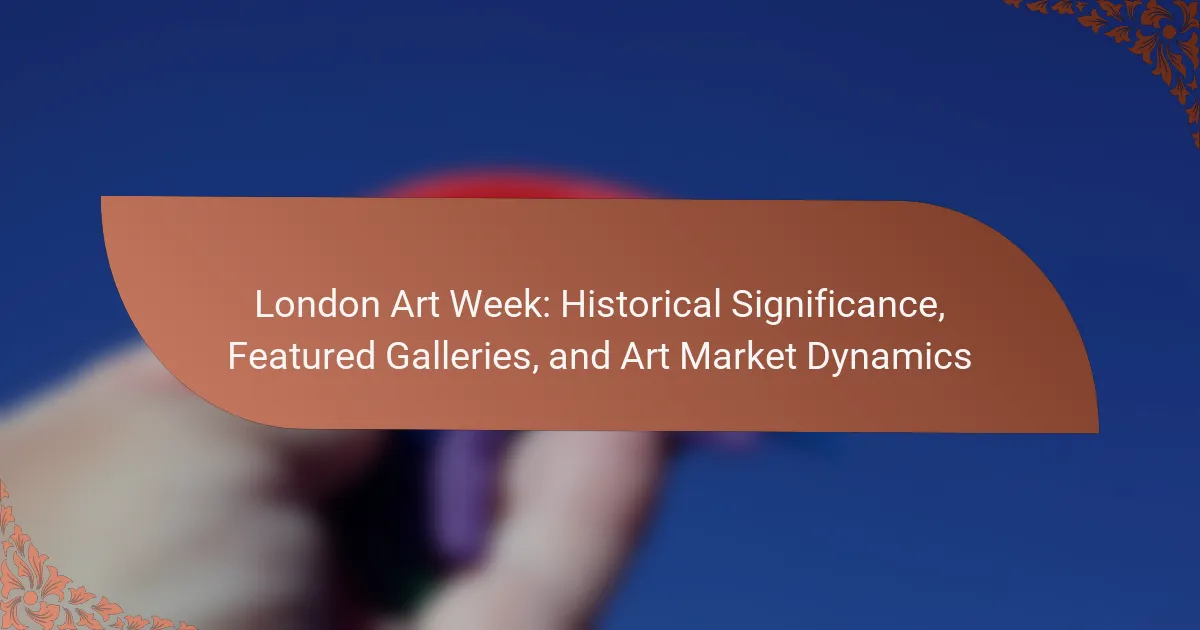London Art Week is a pivotal event for art collectors and enthusiasts, highlighting exceptional artworks and fostering connections in the art market. This article explores its historical significance, features notable galleries like Thomas Gibson Fine Art and Agnew’s, and examines key market dynamics influencing participation and sales. Understanding these elements reveals how London Art Week solidifies the city’s status as a leading art hub.

What is the significance of London Art Week in the global art scene?
London Art Week is significant in the global art scene as it showcases exceptional artworks and fosters connections among collectors, galleries, and artists. This event emphasizes historical significance by featuring galleries that specialize in Old Masters and contemporary art. It enhances the art market dynamics by creating a vibrant platform for buying and selling unique pieces. Additionally, London Art Week attracts international attention, solidifying London’s status as a leading art hub. The event’s focus on quality and authenticity differentiates it from other art fairs, making it a unique gathering for art enthusiasts.
How has London Art Week evolved over the years?
London Art Week has evolved significantly, showcasing a broader range of galleries and enhancing its role in the art market. Initially focused on traditional art forms, it now includes contemporary works, reflecting changing tastes. The event has grown in international participation, attracting collectors and art enthusiasts worldwide. Over the years, it has developed a reputation for fostering dialogue between galleries, artists, and buyers, contributing to the dynamics of the art market.
Why is London Art Week considered a pivotal event for collectors and galleries?
London Art Week is pivotal for collectors and galleries due to its historical significance and market impact. This event showcases significant artworks, attracting prestigious galleries and collectors globally. It fosters connections, enhances visibility for emerging artists, and drives art market dynamics. The week features a diverse range of exhibitions, highlighting both contemporary and historical art. As a result, it serves as a crucial platform for networking and investment opportunities in the art world.
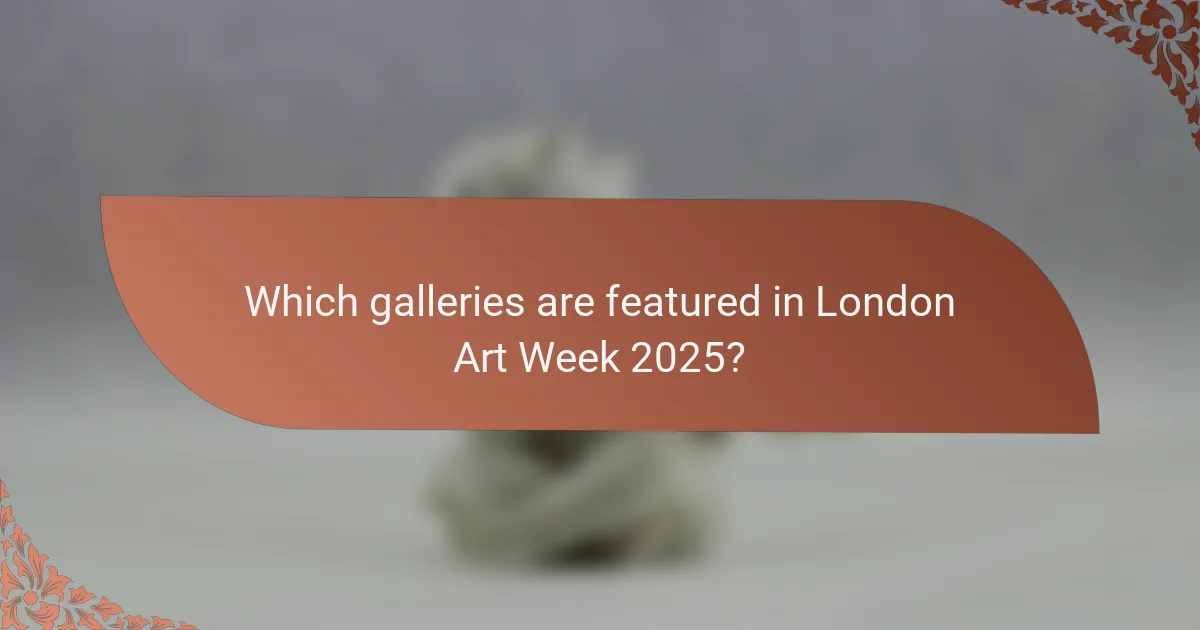
Which galleries are featured in London Art Week 2025?
London Art Week 2025 features notable galleries such as Thomas Gibson Fine Art, Agnew’s, and Richard Green. These galleries showcase a diverse range of artworks, highlighting both historical significance and contemporary trends in the art market. Each gallery contributes unique exhibitions that attract collectors and art enthusiasts alike.
What types of art can be found in participating galleries?
Participating galleries during London Art Week showcase a diverse array of art types. These include contemporary works, historical pieces, and modern masterpieces. You can find paintings, sculptures, photography, and decorative arts. Additionally, some galleries feature rare artifacts and limited edition prints, enhancing the cultural experience.
How do featured galleries curate their collections for the event?
Featured galleries curate their collections by selecting artworks that reflect the event’s theme and historical context. They consider the significance of each piece, ensuring it contributes to the overall narrative of London Art Week. Curators often prioritize works from renowned artists or those with unique attributes, enhancing the event’s appeal. Additionally, galleries may collaborate with collectors and institutions to showcase rare pieces, creating a dynamic and engaging experience for attendees.
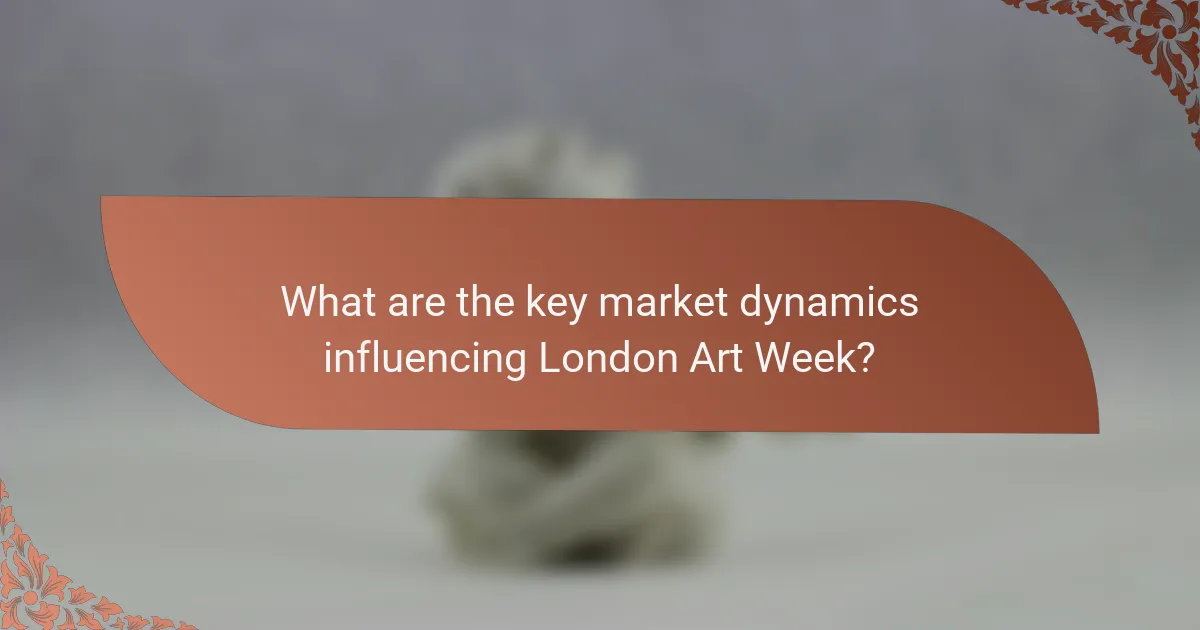
What are the key market dynamics influencing London Art Week?
Key market dynamics influencing London Art Week include economic trends, collector interest, and global art market shifts. The event’s historical significance draws attention, enhancing its appeal. Featured galleries showcase diverse artworks, attracting varied audiences. Additionally, fluctuating auction results impact pricing strategies and participation levels.
How do economic trends impact art sales during the event?
Economic trends significantly influence art sales during London Art Week. A strong economy typically boosts consumer confidence and spending power, leading to increased art purchases. Conversely, economic downturns can result in reduced sales as collectors prioritize essential expenses. Additionally, inflation can affect pricing strategies and perceived value in the art market. Recent data shows that during periods of economic growth, art sales can increase by up to 15%, highlighting the correlation between economic conditions and market dynamics.
What role do international buyers play in the London Art Week market?
International buyers significantly influence the London Art Week market by driving demand and shaping trends. Their participation enhances the visibility of featured galleries and attracts diverse artworks. This global interest contributes to a vibrant art ecosystem, fostering competition and innovation among local artists. Additionally, international buyers often introduce unique perspectives, enriching the cultural narrative of the London art scene. Their purchasing power can elevate the market, impacting pricing and investment in art.
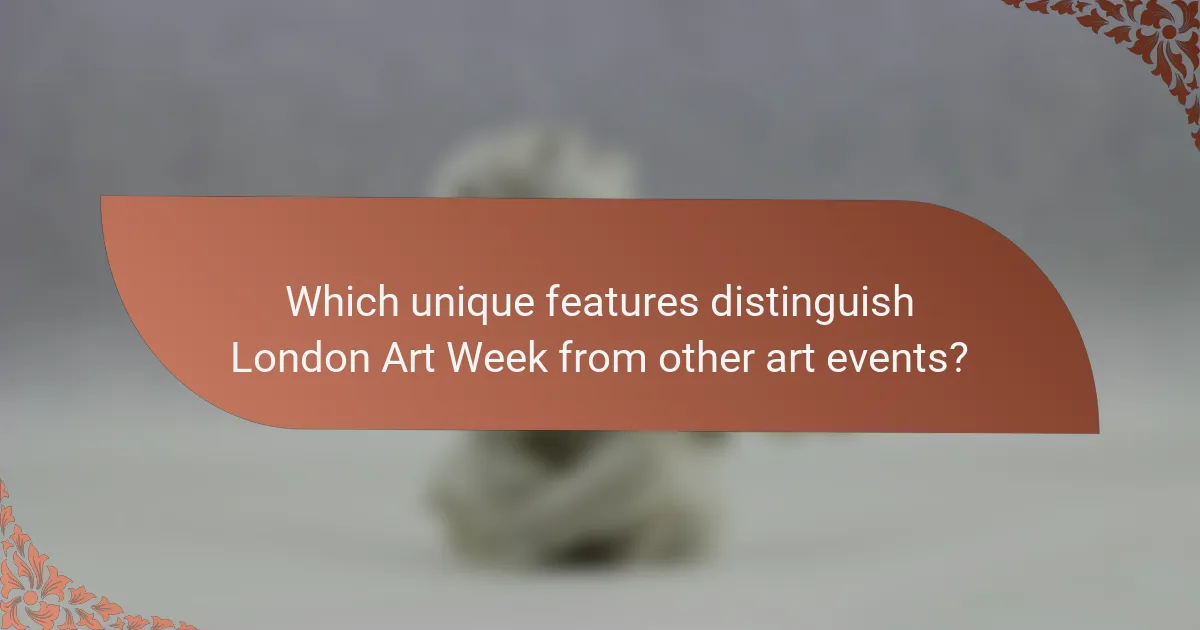
Which unique features distinguish London Art Week from other art events?
London Art Week is distinguished by its focus on historical art, exclusive gallery participation, and its active role in the art market. The event showcases a curated selection of galleries that specialize in fine art, antiques, and modern pieces, creating a unique blend of offerings. Unlike other art fairs, it emphasizes scholarship and connoisseurship, attracting collectors and enthusiasts seeking authenticity. Additionally, London Art Week fosters direct engagement between galleries and buyers, enhancing the art market dynamics through personal interactions and exclusive exhibitions.
How does the event support emerging artists?
London Art Week supports emerging artists by providing them a platform to showcase their work alongside established names. This exposure can lead to increased visibility and potential sales. The event features galleries that prioritize innovative and contemporary art, creating opportunities for new talent to engage with collectors and art enthusiasts. Additionally, workshops and discussions during the week encourage networking and mentorship, fostering a supportive environment for growth. This commitment to nurturing emerging artists is vital for the evolution of the art market.
What exclusive programs are offered during London Art Week?
London Art Week offers exclusive programs such as gallery exhibitions, artist talks, and panel discussions featuring prominent figures in the art world. These events showcase significant historical works and contemporary pieces, enhancing the art market’s dynamics. Participating galleries often present unique collections, emphasizing rare attributes of selected artworks. Notable programs include guided tours that provide insights into the historical significance of showcased pieces.
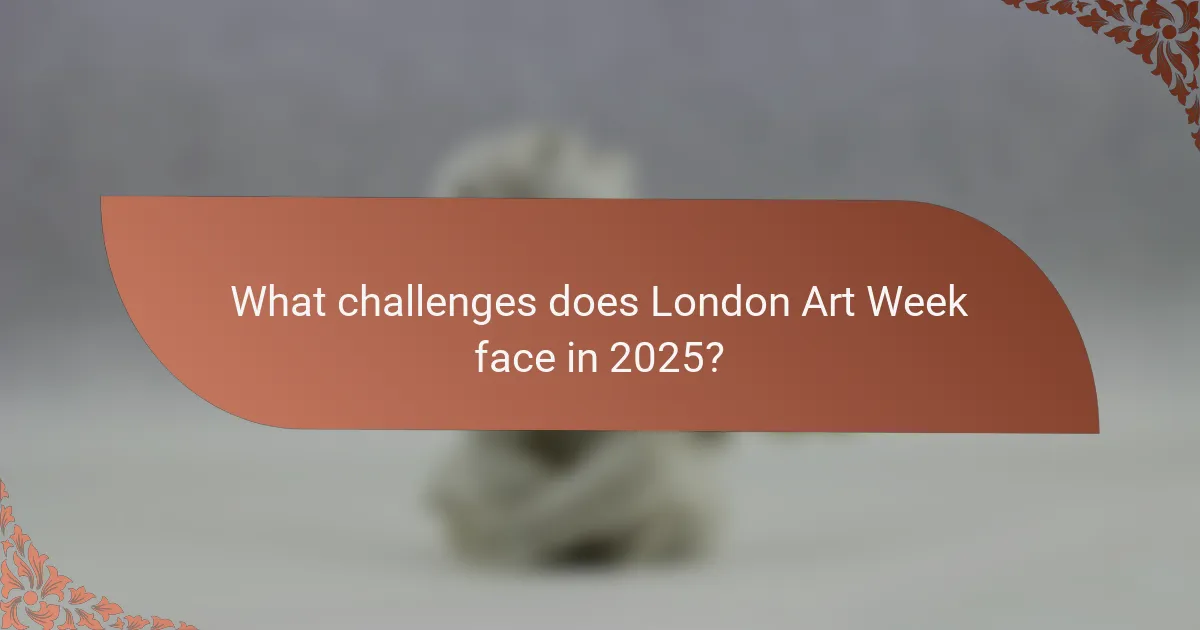
What challenges does London Art Week face in 2025?
London Art Week faces challenges in 2025, including economic fluctuations, competition from online platforms, and evolving audience expectations. The art market’s volatility may impact gallery participation and sales. Additionally, adapting to technological advancements while maintaining a personal connection with patrons proves essential. The unique challenge lies in balancing traditional art appreciation with modern engagement strategies.
How are galleries adapting to changing buyer preferences?
Galleries are adapting by embracing digital platforms, enhancing customer engagement, and diversifying their offerings. The rise of online sales has shifted focus toward virtual exhibitions and social media marketing. Galleries are also curating more inclusive and accessible collections to cater to evolving buyer demographics. As a result, they are fostering community connections and emphasizing experiential art events.
What impact does digital transformation have on the event?
Digital transformation significantly enhances the London Art Week by improving accessibility, engagement, and operational efficiency. It enables galleries to showcase art through virtual exhibitions, reaching a global audience. Enhanced data analytics allows for better understanding of market trends and consumer preferences. As a result, galleries can tailor their offerings, increasing sales opportunities and driving innovation within the art market.
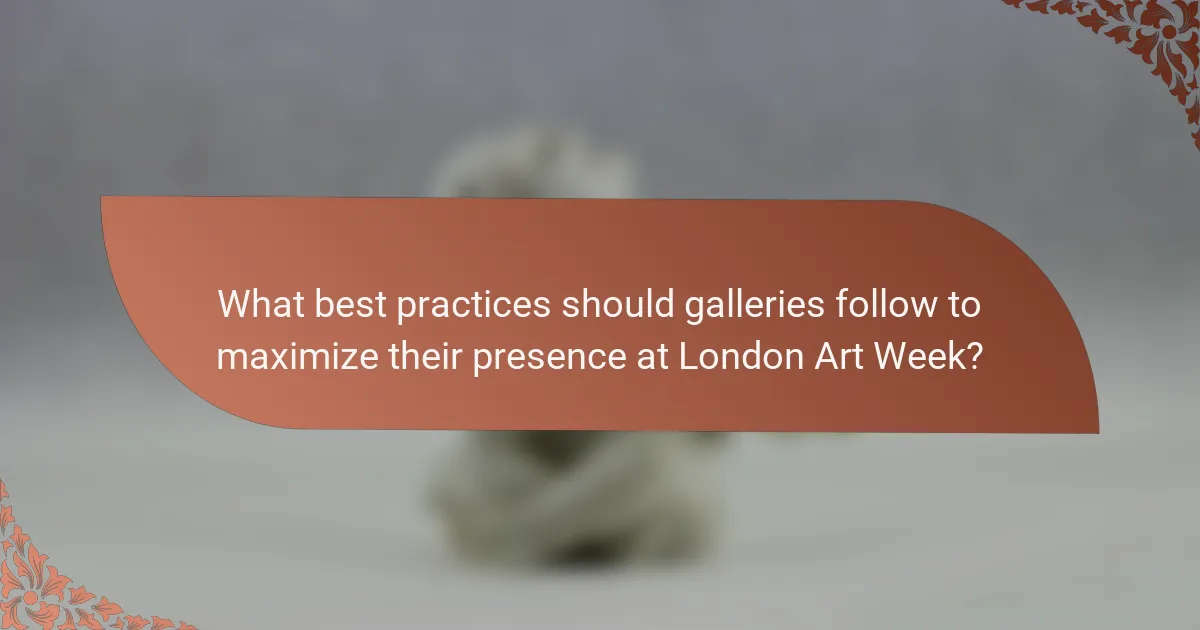
What best practices should galleries follow to maximize their presence at London Art Week?
Galleries should engage actively with audiences, leverage social media, and collaborate with local artists to maximize their presence at London Art Week. Building strong relationships with collectors and curators enhances visibility.
Offering exclusive previews and events creates buzz and attracts visitors. Additionally, utilizing innovative display techniques showcases artworks effectively. Galleries can also participate in panel discussions to establish authority in the art market.
How can galleries effectively engage with collectors during the event?
Galleries can engage effectively with collectors during events by creating personalized experiences and fostering direct communication. Establishing dedicated spaces for private viewings enhances collector interaction. Offering curated tours allows galleries to showcase featured artworks meaningfully. Additionally, hosting panel discussions with artists and experts can deepen collectors’ understanding of the art market dynamics. Using digital platforms for follow-ups keeps the conversation ongoing, reinforcing relationships beyond the event.
What marketing strategies work best for promoting exhibitions at London Art Week?
Engaging marketing strategies for promoting exhibitions at London Art Week include targeted social media campaigns, influencer partnerships, and curated email newsletters. These methods effectively reach art enthusiasts and collectors, enhancing visibility and attendance.
Social media campaigns leverage platforms like Instagram and Facebook to showcase featured galleries and artworks, attracting a visually-driven audience. Influencer partnerships amplify reach through trusted voices in the art community, providing authentic recommendations. Curated email newsletters deliver personalized content to subscribers, highlighting event details and exclusive previews.
Combining these strategies can create a compelling promotional mix that resonates with diverse audiences, driving interest and participation in London Art Week.
